澳大利亚的高等教育
澳大利亚高等教育的主要特征及其经验借鉴

院 成 立 到 第 二 次 世 界 大 战 结 束 的 近 一 百 年 间,澳大利 亚的高等教 育基本上仍然 保持 6
个 州 各 拥 有 一所 大 学 的 局 面 。 自澳 大 利 亚 1 4 年 在 首 都 堪 培 拉 建立 96 澳 大 利 亚 国 立 大 学 ( 9 0 年 前 为 研 究 生 教 16
..
促 进 了澳 大 利 亚 高等 教 育 的 发 展 。第 一 , 自
人 , 高等 教 育 毛 入 学 率 达 2 . % ,分 别 是 同 77
年 世 界 相 应 平 均 数 ( 2 5人 和 1 . % ) 19 14 2 9 的 .
(9 1 ) 1 1 年 。虽 然 澳 大利 亚根 据 13 年 英 国 91 国会 批 准 的 “ 斯 敏 斯 特 法 案 ” 获 得 内政 外 威 交 的 独 立 自主权 ,但 是 全 国 高等 教 育 并 未 提
第 一 个 殖 民城 市 悉 尼 开 始 , 澳 大 利 亚 逐 渐 沦
为 英 国 的殖 民地 并 逐 渐 开 始 移植 英 国 的 高 等 教 育 办 学 模 式 。 比 如 说 ,作 为澳 大 利 亚 第 一 所 高 等 学 校 、创 建 于 15 年 的 私 立 悉 尼 学 80 院 ( 即位 于 新 南威 尔 士 州 首 府 的 悉 尼 大 学 的 前 身 ,第 二 次 世 界 大 战 后 改 为 公 立 ) 就 是 , 效 仿 英 国 大 学 传 统 而 成 立 的 ,其 初 衷 是 培 养 澳 大 利 亚 联 邦 各 州 的 政 治 、学 术 精 英 。综 观
澳大利亚高等教育毕业声明

澳大利亚高等教育毕业声明
澳大利亚高等教育毕业声明,通常称为Graduate Statement,在澳大利亚高等教育体系中是一份重要的文件。
该声明通常由大学或其他教育机构发放给学生,在完成学业并获得学位后提供。
澳大利亚高等教育毕业声明包含以下信息:
1. 学生的个人信息,包括姓名、学生号码和联系方式。
2. 所获得的学位或文凭的详细信息,包括专业、学习方向和学位级别。
3. 学生在学业中的表现和成绩,包括平均成绩、荣誉奖项和其他相关荣誉。
4. 学生完成学业所花费的时间,包括入学日期和毕业日期。
5. 学生参与的额外学习和实践经验,如实习、实验室工作或志愿者活动。
6. 毕业学生在澳大利亚教育体系中所获得的技能和知识。
澳大利亚高等教育毕业声明是对学生在大学期间所取得成就的正式认可,并被广泛接受和认可。
它在学生毕业后寻找工作、继续深造或移民到其他国家时非常重要。
澳大利亚的高等教育体系
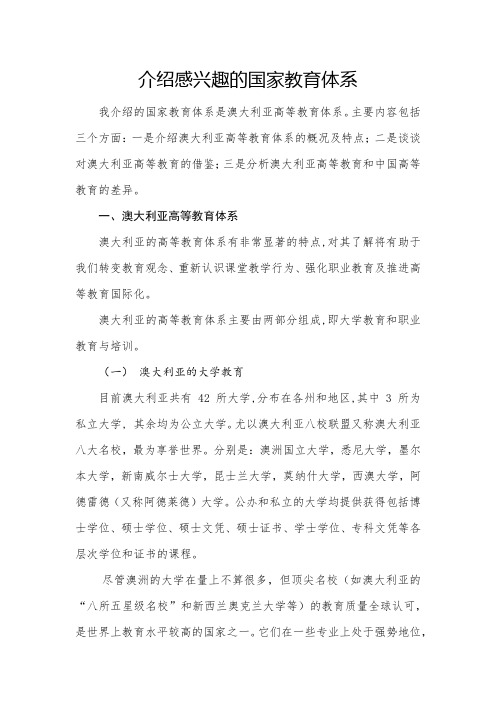
介绍感兴趣的国家教育体系我介绍的国家教育体系是澳大利亚高等教育体系。
主要内容包括三个方面:一是介绍澳大利亚高等教育体系的概况及特点;二是谈谈对澳大利亚高等教育的借鉴;三是分析澳大利亚高等教育和中国高等教育的差异。
一、澳大利亚高等教育体系澳大利亚的高等教育体系有非常显著的特点,对其了解将有助于我们转变教育观念、重新认识课堂教学行为、强化职业教育及推进高等教育国际化。
澳大利亚的高等教育体系主要由两部分组成,即大学教育和职业教育与培训。
(一)澳大利亚的大学教育目前澳大利亚共有 42 所大学,分布在各州和地区,其中3所为私立大学, 其余均为公立大学。
尤以澳大利亚八校联盟又称澳大利亚八大名校,最为享誉世界。
分别是:澳洲国立大学,悉尼大学,墨尔本大学,新南威尔士大学,昆士兰大学,莫纳什大学,西澳大学,阿德雷德(又称阿德莱德)大学。
公办和私立的大学均提供获得包括博士学位、硕士学位、硕士文凭、硕士证书、学士学位、专科文凭等各层次学位和证书的课程。
尽管澳洲的大学在量上不算很多,但顶尖名校(如澳大利亚的“八所五星级名校”和新西兰奥克兰大学等)的教育质量全球认可,是世界上教育水平较高的国家之一。
它们在一些专业上处于强势地位,如会计、医科,以及部分新兴专业。
(二)技术与继续教育澳大利亚的教育制度非常完善,不仅有包括世界百强名校在内的42所大学,还有300多所专科技术学院。
技术继续教育学院相当于中国高等职业教育层次,是由澳大利亚联邦政府和各州政府共同投资兴建并进行管理,主要提供专业技能的训练课程,大部分课程都更具实用性。
它作为澳大利亚一种独特的职业教育培训体系存在至今已有100多年的历史,也是全球最成功的特色鲜明的教育体系之一。
其最大特色就是以能力为本位、以职业为导向。
“毕业即就业”“帮助每个学生尽快找到工作”,是技术与继续教育理想和终极目标。
在澳大利亚,专科技术学院是澳大利亚高等教育的主力军,除了职业教育培训外,还与各大院校紧密联系,为学生提供各种渠道的升学机会。
澳大利亚的高等教育 澳大利亚高等教育质量
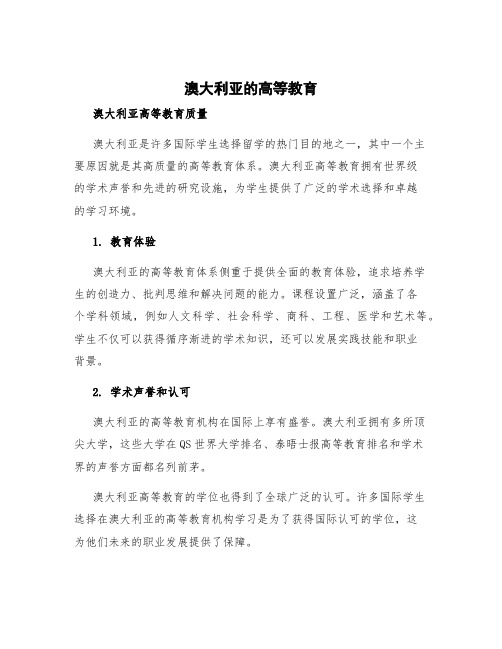
澳大利亚的高等教育澳大利亚高等教育质量澳大利亚是许多国际学生选择留学的热门目的地之一,其中一个主要原因就是其高质量的高等教育体系。
澳大利亚高等教育拥有世界级的学术声誉和先进的研究设施,为学生提供了广泛的学术选择和卓越的学习环境。
1. 教育体验澳大利亚的高等教育体系侧重于提供全面的教育体验,追求培养学生的创造力、批判思维和解决问题的能力。
课程设置广泛,涵盖了各个学科领域,例如人文科学、社会科学、商科、工程、医学和艺术等。
学生不仅可以获得循序渐进的学术知识,还可以发展实践技能和职业背景。
2. 学术声誉和认可澳大利亚的高等教育机构在国际上享有盛誉。
澳大利亚拥有多所顶尖大学,这些大学在QS世界大学排名、泰晤士报高等教育排名和学术界的声誉方面都名列前茅。
澳大利亚高等教育的学位也得到了全球广泛的认可。
许多国际学生选择在澳大利亚的高等教育机构学习是为了获得国际认可的学位,这为他们未来的职业发展提供了保障。
3. 优质的教师团队澳大利亚的高等教育机构引进了许多世界级的教育者和研究者,为学生提供了优质的教育服务。
这些教师不仅拥有丰富的学术知识和教学经验,还积极参与前沿研究和学术创新。
他们不仅关注学生的学习成果,更注重培养学生的批判思维、创新能力和领导潜力。
4. 先进的研究设施澳大利亚的高等教育机构投资了大量资源来建设先进的研究设施和实验室。
这些设施不仅为研究人员提供了良好的工作环境,也为学生提供了实践和研究的机会。
学生有机会参与到真实的研究项目中,从而将课堂上学到的理论知识应用到实际中。
5. 多元化的学习机会澳大利亚的高等教育致力于提供多元化的学习机会,以满足学生不同的学习需求和兴趣。
学生可以选择不同的学习模式,例如全日制学习、兼职学习和在线学习。
此外,许多高等教育机构还提供丰富多样的课外活动和实习机会,为学生提供全面发展的机会。
6. 国际学生支持和社交活动澳大利亚高等教育机构对国际学生提供了广泛的支持和服务。
学校设有国际学生办公室,为国际学生提供入学咨询、生活指导和文化适应等方面的帮助。
australian higher education graduation statement

australian higher education graduation statement摘要:1.澳大利亚高等教育毕业声明简介2.澳大利亚高等教育毕业声明的发展历程3.澳大利亚高等教育毕业声明的主要内容4.澳大利亚高等教育毕业声明的实施效果与影响5.我国对澳大利亚高等教育毕业声明的借鉴意义正文:【澳大利亚高等教育毕业声明简介】澳大利亚高等教育毕业声明(Australian Higher Education Graduation Statement,简称AHEGS)是澳大利亚高等教育机构颁发给毕业生的一种官方文件,用于证明毕业生的学位和学历信息。
AHEGS 旨在为毕业生提供一个便携、权威的学历证明,方便他们在国内外就业和升学。
【澳大利亚高等教育毕业声明的发展历程】澳大利亚高等教育毕业声明的发展历程可以追溯到上世纪90 年代。
当时,澳大利亚高等教育机构开始意识到,传统的学位证书和成绩单形式已经无法满足毕业生在全球范围内就业和升学的需求。
因此,澳大利亚高等教育部门开始着手设计一种新的证明文件,以便更好地服务于毕业生。
经过多年的探讨和实践,AHEGS 应运而生。
【澳大利亚高等教育毕业声明的主要内容】澳大利亚高等教育毕业声明主要包括以下内容:1.毕业生的基本个人信息,如姓名、性别、出生日期等;2.毕业生所获得的学位和专业名称;3.毕业生的就读学校和在校时间;4.毕业生的毕业时间;5.毕业生的成绩单,包括各门课程的成绩和学分;6.毕业生的学位授予机构和学位类型;7.其他相关信息,如荣誉学位、奖学金等。
【澳大利亚高等教育毕业声明的实施效果与影响】澳大利亚高等教育毕业声明的实施,为毕业生提供了一种权威、便捷的学历证明方式。
这不仅有利于毕业生在国内外就业和升学,还有助于提高澳大利亚高等教育的国际声誉。
此外,AHEGS 的推行还促进了澳大利亚高等教育机构之间的交流与合作,为提高教育质量创造了有利条件。
【我国对澳大利亚高等教育毕业声明的借鉴意义】我国可以借鉴澳大利亚高等教育毕业声明的成功经验,推出类似的学历证明文件。
australian higher education graduation statement
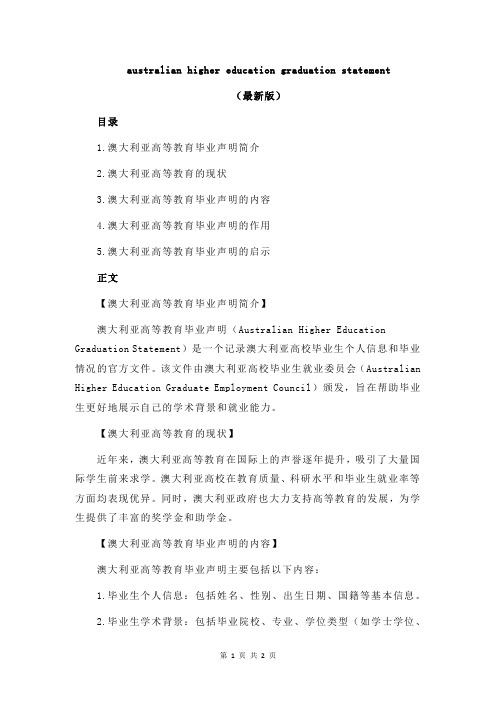
australian higher education graduation statement(最新版)目录1.澳大利亚高等教育毕业声明简介2.澳大利亚高等教育的现状3.澳大利亚高等教育毕业声明的内容4.澳大利亚高等教育毕业声明的作用5.澳大利亚高等教育毕业声明的启示正文【澳大利亚高等教育毕业声明简介】澳大利亚高等教育毕业声明(Australian Higher Education Graduation Statement)是一个记录澳大利亚高校毕业生个人信息和毕业情况的官方文件。
该文件由澳大利亚高校毕业生就业委员会(Australian Higher Education Graduate Employment Council)颁发,旨在帮助毕业生更好地展示自己的学术背景和就业能力。
【澳大利亚高等教育的现状】近年来,澳大利亚高等教育在国际上的声誉逐年提升,吸引了大量国际学生前来求学。
澳大利亚高校在教育质量、科研水平和毕业生就业率等方面均表现优异。
同时,澳大利亚政府也大力支持高等教育的发展,为学生提供了丰富的奖学金和助学金。
【澳大利亚高等教育毕业声明的内容】澳大利亚高等教育毕业声明主要包括以下内容:1.毕业生个人信息:包括姓名、性别、出生日期、国籍等基本信息。
2.毕业生学术背景:包括毕业院校、专业、学位类型(如学士学位、硕士学位等)、毕业时间等。
3.毕业生成绩情况:包括各科目成绩、平均分、绩点等。
4.毕业生实践经历:如有实习、实践项目等经历,也将在声明中体现。
5.毕业生技能和特长:毕业生可以在声明中自我评价,描述自己的技能、特长和兴趣爱好。
【澳大利亚高等教育毕业声明的作用】澳大利亚高等教育毕业声明对于毕业生具有重要意义:1.增加毕业生就业竞争力:通过展示个人的学术背景、成绩和实践经历,有助于毕业生在求职过程中脱颖而出,提高就业竞争力。
2.便于雇主了解毕业生情况:毕业声明的详细信息有助于雇主快速了解毕业生的背景和能力,节省招聘成本。
澳洲留学八大学校排名
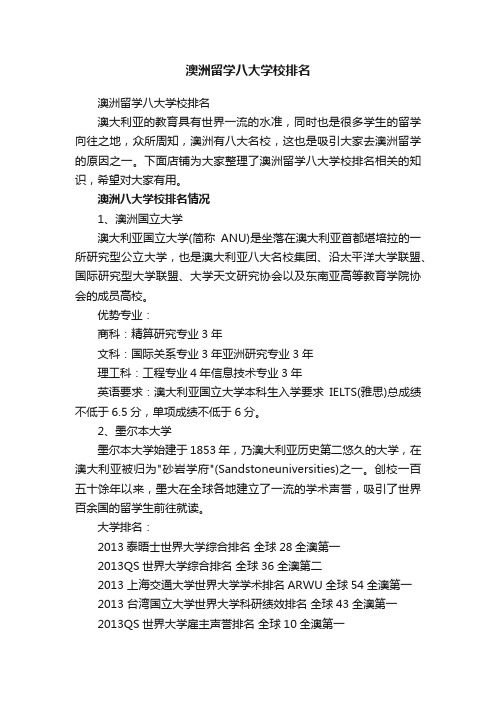
澳洲留学八大学校排名澳洲留学八大学校排名澳大利亚的教育具有世界一流的水准,同时也是很多学生的留学向往之地,众所周知,澳洲有八大名校,这也是吸引大家去澳洲留学的原因之一。
下面店铺为大家整理了澳洲留学八大学校排名相关的知识,希望对大家有用。
澳洲八大学校排名情况1、澳洲国立大学澳大利亚国立大学(简称ANU)是坐落在澳大利亚首都堪培拉的一所研究型公立大学,也是澳大利亚八大名校集团、沿太平洋大学联盟、国际研究型大学联盟、大学天文研究协会以及东南亚高等教育学院协会的成员高校。
优势专业:商科:精算研究专业3年文科:国际关系专业3年亚洲研究专业3年理工科:工程专业4年信息技术专业3年英语要求:澳大利亚国立大学本科生入学要求IELTS(雅思)总成绩不低于6.5分,单项成绩不低于6分。
2、墨尔本大学墨尔本大学始建于1853年,乃澳大利亚历史第二悠久的大学,在澳大利亚被归为"砂岩学府"(Sandstoneuniversities)之一。
创校一百五十馀年以来,墨大在全球各地建立了一流的学术声誉,吸引了世界百余国的留学生前往就读。
大学排名:2013泰晤士世界大学综合排名全球28全澳第一2013QS世界大学综合排名全球36全澳第二2013 上海交通大学世界大学学术排名ARWU全球54全澳第一2013 台湾国立大学世界大学科研绩效排名全球43全澳第一2013QS世界大学雇主声誉排名全球10全澳第一2013泰晤士世界大学雇主声誉排名全球43全澳第一2012 澳洲教育署排名ERA 全澳综合第一优势专业:(4年可获荣誉学士学位)商科:商学专业3年文科:艺术专业3年理工科:生物制药专业环境专业建筑工程3年英语要求:墨尔本大学本科生入学要求IELTS(雅思)总成绩不低于6.5分,单项成绩不低于6分。
3、悉尼大学悉尼大学(UniversityofSydney)是澳大利亚历史最悠久的大学,创立于1850年。
悉大是澳大利亚八大名校的成员,并一直都是全国规模最大的学术机构。
澳大利亚高等教育
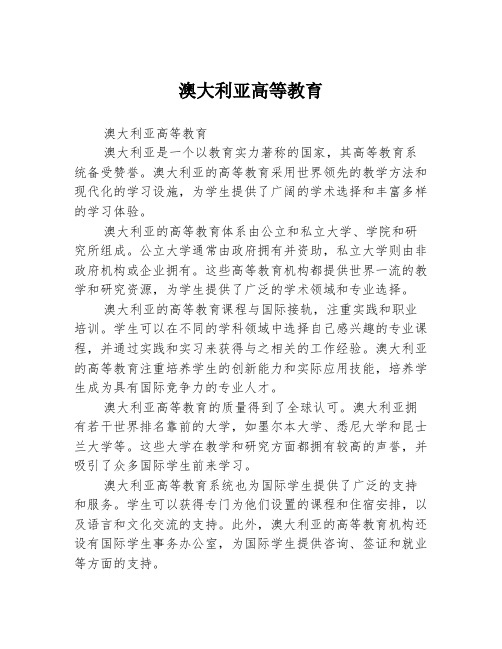
澳大利亚高等教育澳大利亚高等教育澳大利亚是一个以教育实力著称的国家,其高等教育系统备受赞誉。
澳大利亚的高等教育采用世界领先的教学方法和现代化的学习设施,为学生提供了广阔的学术选择和丰富多样的学习体验。
澳大利亚的高等教育体系由公立和私立大学、学院和研究所组成。
公立大学通常由政府拥有并资助,私立大学则由非政府机构或企业拥有。
这些高等教育机构都提供世界一流的教学和研究资源,为学生提供了广泛的学术领域和专业选择。
澳大利亚的高等教育课程与国际接轨,注重实践和职业培训。
学生可以在不同的学科领域中选择自己感兴趣的专业课程,并通过实践和实习来获得与之相关的工作经验。
澳大利亚的高等教育注重培养学生的创新能力和实际应用技能,培养学生成为具有国际竞争力的专业人才。
澳大利亚高等教育的质量得到了全球认可。
澳大利亚拥有若干世界排名靠前的大学,如墨尔本大学、悉尼大学和昆士兰大学等。
这些大学在教学和研究方面都拥有较高的声誉,并吸引了众多国际学生前来学习。
澳大利亚高等教育系统也为国际学生提供了广泛的支持和服务。
学生可以获得专门为他们设置的课程和住宿安排,以及语言和文化交流的支持。
此外,澳大利亚的高等教育机构还设有国际学生事务办公室,为国际学生提供咨询、签证和就业等方面的支持。
澳大利亚高等教育的费用相对较高,但由于澳大利亚政府对国际学生的资助政策和奖学金计划,许多国际学生可以获得一定的学费减免或奖学金资助。
此外,学生还可以通过在校园内工作来补贴生活费用。
澳大利亚的高等教育费用相对较低,生活成本也较为合理,这使得澳大利亚成为许多国际学生的理想留学目的地之一。
总之,澳大利亚的高等教育以其卓越的教学质量、实践导向的课程设置和良好的国际学生支持服务而闻名。
澳大利亚的高等教育机构提供广阔的学术选择和丰富多样的学习体验,为学生打造了一个世界一流的学术和职业发展平台。
无论是在学术领域的深造还是实践技能的培养,澳大利亚高等教育都能满足学生的需求,并帮助他们实现自己的职业目标。
澳大利亚高等教育质量管理与标准署概述

澳大利亚高等教育质量管理与标准署概述
澳大利亚高等教育质量管理与标准署(TEQSA)是澳大利亚政府设立的独立机构,负责监管澳大利亚所有高等教育机构的质量和标准。
TEQSA的使命是确保澳大利亚的高等教育系统持续提供高质量的教育,满足学生的需求,并确保澳大利亚的高等教育机构在国际上具有竞争力。
TEQSA的主要职责是审查和审批澳大利亚的高等教育机构的注册申请,监督它们的质量和标准,并定期对其进行评估。
TEQSA还负责审查和审批高等教育机构的教学计划,学位和课程,以及认可和认证其他教育机构。
TEQSA还负责审查和审批澳大利亚高等教育机构的学术教职员工,以确保他们拥有正确的资格和能力。
TEQSA通过提供信息和支持来帮助澳大利亚高等教育机构提高质量和标准。
它还负责收集和分析有关澳大利亚高等教育的信息,并向政府提供建议,以确保澳大利亚的高等教育系统能够持续为学生提供最高质量的教育。
中国和澳大利亚的教育系统有何异同?

中国和澳大利亚的教育系统有何异同?中国和澳大利亚都是具有领先地位的国家,教育作为一个重要领域在两国都受到高度重视。
但是,中国和澳大利亚的教育系统有很大的不同,下面我们来看看两国教育系统的异同点。
一、教育制度中国的教育制度是由国家全面控制的,从小学到高中,都有统一的教学方案和统一的标准化考试。
同时,中国的高等教育制度也是由国家部门进行管理,大学的招生考试也是通过政府出题,学生凭借考试成绩来申请院校。
而澳大利亚的教育制度更加自由灵活,拥有更大的教育自主权。
澳大利亚的教育系统由各地州政府或私立机构负责管理,学生在完成12年义务教育后可以直接进入职场,也可以选择去大学深造。
澳大利亚的高等教育制度与中国不同,不会在入学前进行标准化考试,而是在完成预科阶段后,通过大学的面试和学校成绩来决定是否被录取。
二、教育内容和方法中国的教育内容着重于学生的学科成绩,注重传统的学科知识教育,像数学、语文、物理和生物等科目,同时注重学生的基础理论和应用技能。
中国的教育方法是以传统的授课方式为主,学生通过课堂教学和模拟考试来检验学习成果。
澳大利亚的教育系统则注重学生的全面发展,教育内容包括体育、音乐、艺术等传统文化和社交技能。
澳大利亚的教育方法比较自由和灵活,学生的学习方式更加多样化,注重举办文化活动和课程实践,旨在提高学生的综合素质。
三、教育资源中国和澳大利亚在教育资源上也存在一些不同。
中国拥有庞大的教育资源,有顶尖的学校和教育机构,同时拥有先进的教育科技和多媒体技术支持。
中国的教育资源实力在全球范围内都是非常强劲的。
澳大利亚的教育资源也很丰富,特别是在高等教育领域,有很多世界著名的大学和研究机构,同时澳大利亚的教育资源也比较多元化,可以提供不同类型和风格的学习体验。
总结起来,中国和澳大利亚的教育系统存在很大的差异,但它们都有自己独特的教育方式和特点。
在现代社会,教育不仅仅涵盖了知识方面,还应该注重学生的社会技能和培养他们的思维能力,通过双方的教育模式的比较,可以为两国的教育发展提供重要的参考和借鉴。
澳大利亚学校教育制度特点

澳大利亚学校教育制度特点澳大利亚的教育制度是以政府为主导的公立教育体系,同时也有一些私立学校。
其中,公立学校的数量和规模是最大的。
澳大利亚的教育制度为学生提供了多元化的学习选择,并注重学生的综合素质发展。
教育阶段分明澳大利亚的教育制度,首先表现在教育阶段上的分明性。
澳大利亚的教育制度分为小学(Primary School)、中学(Secondary School)和大学(Tertiary Education)三个阶段。
小学学制是六年,中学学制是六年,高级中学学制是两年。
教育从小学开始,直到高中毕业,是12年的制度。
小学教育是6-12岁的基础教育阶段,包括读写、数学、科学、社会研究等学科。
这个阶段注重培养学生的基本认知能力、沟通技巧和社交能力。
中学教育是12-18岁的教育阶段,学生学习各种学科,并且在这个阶段进行高中毕业考试(Higher School Certificate)的考试,这个考试对于学生进入大学以及未来的职业发展都有非常重要的影响。
大学教育是18岁以上的高等教育阶段,大学教育分为学士、硕士、博士三个阶段。
语言、商科、科技和医学等领域都可以选择专业。
公办和私立学校并存澳大利亚的教育制度,其次表现在公办和私立学校的并存上。
在澳大利亚,公立学校在教育领域扮演着主导地位。
据统计,公立学校占据了澳大利亚大部分的学生人数。
同时,澳大利亚也有一些私立学校,这些学校的教育质量和设施比公立学校更为优越。
许多中产阶级的家庭会选择发送孩子去私立学校,这些学校会为学生提供更好的资源、高质量的教育和更小的班级规模等优势。
重视多元化学习选择澳大利亚的教育制度,第三表现在学生学习选择的多元化上。
在澳大利亚,学生可以根据自己的兴趣、能力和职业目标来选择自己的学习方向。
澳大利亚的教育制度注重学生的专业选择,鼓励学生在高中时选修自己感兴趣的学科,为未来的职业目标做准备。
此外,澳大利亚的教育体系对于非传统的教育途径也非常开放。
澳大利亚高等教育改革研究

澳大利亚高等教育改革研究澳大利亚作为全球优质高等教育体系的代表,一直致力于进一步提升教育水平和质量。
近年来,澳大利亚政府通过一系列改革,以适应快速变化的全球化和数字化时代。
这些改革旨在更好地支持学生,增加国际竞争力,并提高社会效益。
一项重要的改革是2017年实施的澳大利亚高等教育质量框架(HEQF)。
该框架根据澳大利亚学历框架(AQF)制定,旨在为学生提供高质量的教育和培训。
HEQF包含八个学科领域,涵盖完整的学习体验,包括学习成果、课程设计、教学方法和评估。
该框架促进了高等教育的质量和一致性,并帮助学生更好地了解他们的课程和未来职业的相关要求。
除了HEQF,澳大利亚高等教育还面临其他诸多挑战和机遇,例如:数字化教育:随着技术的进步,澳大利亚高等教育机构逐渐转向数字化教育。
这使得学生可以灵活地、自主地、高效地学习,同时为教育机构和教师提供更多的教学资源和工具。
国际化竞争:澳大利亚高等教育机构面临来自全球的竞争,国际化程度不断提高。
为了维持其国际领先地位,澳大利亚高等教育机构需要与外国机构建立合作关系,招收更多本国以外的学生,并推动国际性研究项目。
改善就业率:澳大利亚政府鼓励学校开设实用的、与市场需求匹配的课程,以提升学生的就业能力。
同时,政府还促进了大学和企业之间的合作,以更好地培养学生与市场需求对接的专业技能。
此外,澳大利亚高等教育的改革还涉及到学费、奖学金和助学贷款等方面。
尽管存在一些争议和挑战,但澳大利亚高等教育的改革依然在探索和实践中不断前行,帮助学生在新时代中更好地成长和发展。
澳大利亚高等教育以人为本的特点与启示

澳大利亚高等教育“以人为本"的特点与启示张颖(鞍山师范学院国际交流合作处,辽宁鞍山114007)摘要:澳大利亚实践证明.高等教育从精英型到大众化再到普及化发展的过程.以人为本是高等教育发展必须始终坚持的理念。
把大学生培养成既具有国际知识.又拥有国际眼光和国际情感的通用型外向型人才。
有利于国家问的合作研究、联合办学、信息交流、资源共享。
澳大利亚的高等教育的特点将对我国高等教育的发展具有有较好的借鉴作用。
关键词:澳大利亚高等教育以人为本澳大利亚承袭英国式的教育制度,其教育质量具有世界一流水准.所有学校教育都是根据个人的需要、能力与兴趣而设.使得每个学生都得以发挥其各方面的潜能.并运用到各行各业中。
教育体制是由州政府各自管辖。
但教育质量基本上是由澳大利亚联邦政府严格控制管理的。
各学校的学历文凭,是被各州相互认同且全国通行的。
澳大利亚的学历资格。
被世界各国广泛承认。
经统计,澳大利亚高等教育部分包括37所公立大学,3所私立大学,以及其它4所自我认证f SenA c cr edi t-i n囝的高等教育机构。
另外,澳大利亚还有l o o多所由州或地区当局认可的高等教育机构。
他们提供的课程包括神学、商业和信息科技以及艺术和保健等专业教育。
根据澳大利亚《2003年高等教育支持法(H E SA)》,澳大利亚高校可以分为:三类:A类高校、B类高校和未列入高校,其中A类高校有39所。
是澳大利亚本科及研究生教育的主要机构。
政府投入是其最大收入来源。
澳大利亚高等教育经过150余年的发展.形成了自己的特色。
高等教育的办学理念“以人为本”,大学的发展以学生为中心,非常尊重学生的地位,维护学生的权益,保障学生的安全,注重学生的成长与发展,澳大利亚高校完全做到了“一切为了学生、为了学生的一切、为了一切学生”,这可以从以下几个方面体现:一、人性化服务随处可见一是澳大利亚人部分高校都设有一个专门的调查办公室,学生可以通过建议、投诉、调查问卷以及参与学校某些决策过程来体现自己的意志。
澳大利亚高等教育的有机组成部分——“非大学高等院校”
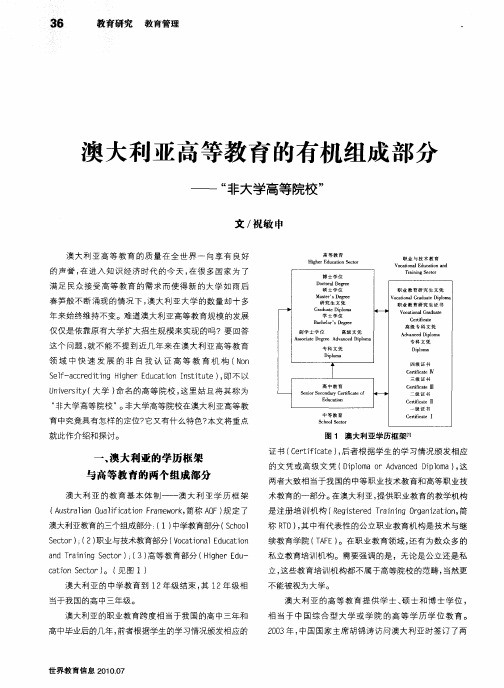
澳大利亚教育 的三个 组成 部分 : 1) ( 中学教育部分 ( col Sho Sco )( ) etr ;2 职业 与技术教育部分 (oainl d cto Vctoa Euain
a d T ann e t r) ( 高等 教 育部分 ( ih rE u n ri ig S co ; 3) Hg e d —
学 士 、 士和 博士 学位 , 各 有不 同特 点 。 ( 硕 但 见表 1) 在 澳 大利 亚 , 大 学 高 等 院校 在 具 备 多 学科 教 学和 非
澳 大利 亚 大学 的 所有 权 与治 理 权相 对分 立 。如 公 立 大学 为 州政 府或 联 邦 政府 所 有 ,但政 府 并不 直 接管 理大
与高等教 育的两个组成部分
澳 大 利 亚 的 教 育 基 本 体 制 —— 澳 大 利 亚 学 历 框 架 ( utain Q aiia in Fa e o k 简称 A F) 定 了 A s rl u lfcto r m w r , a Q 规
是注 册培 训机 构 ( e i ee riigOgnzto , Rgs rdTann raiain 简 t 称 RO)其 中有代 表 性 的公立 职业 教育 机构 是 技术 与继 T , 续教 育学 院 ( AE) T F 。在 职业 教育 领域 , 还有 为数 众 多 的
高 等 教 育 H ge d ct nS c r i r u a o et h E i o
职业 与技 术 教 育
Vo ain lE u a in a d c to a d c t n o
这个 问题 , 不 能不 提 到 近几 年 来 在澳 大 利 亚高 等教 育 就 领 域 中 快 速 发 展 的 非 自 我 认 证 高 等 教 育 机 构 ( o Nn
澳大利亚高等教育一窥及与中国的对比和研究

重 庆三峡 医药 高等专科 学校
引言
岳
西
澳大利 亚是南半球 最发达 的国家 , 澳大利 亚的高等教 育以其高质 量的水准 、 现代化 的教 育理 念享誉 全球 , 澳大利亚的高等教育 以公立 为 为主 ( 教育部认可 的澳 大利 亚4 2 所 大学 , 只有 3 所私立 ) , 培养人才 的层 次与我国相似 , 分为研究生 , 本科 生及 职业教育( 英文 T A F E ) , 其 中研究 生又分为博 士研究生 和硕士研究生 , 然而 由于澳大利亚属 于英联邦 国 家, 高等 教育的人才 培养 层次又 与我国略有不 同 , 显得相对 细化 : 硕士 阶段分为授 课型硕士研 究生和研究 型硕士研究 生 , 本科 阶段 又分为荣 誉 学 士和 学士 。职业 教育 T A F E ( T e c h n i c a l a n d F u r t h e r E d u c a t i o n 1 也属 于高等教育 , 与我 国的高等职业教育 相对 应 , 相当于我国的高等职业教 育, T A F E学术含量较低。 1 . 澳大利 亚高等教 育体 系结构 澳大利亚高 等教育各层 次培养 目标 及职能 明确 , 由于澳 大利亚属 于英 联邦 国家 , 高等教育与我 国相 比培养层 次更 加细化 , 除 了博士研究 生, 硕 士研究生分为研究型硕士和授课 型硕 士 , 本科 又分为荣誉学士和 学士 , 另 外 还有 研究 生 ( 本科) 文凭, 证 书等课 程 。对 于博 士 研究 生 ( P H D学术 型博士 ) , 澳 大利亚 高校一般对 各专业 均设有 全额奖学 金 , 博士研究 生 ( P H D ) 完全是 学术型的高级学位 , 对该类人 才的培养 , 国家 极 为重视 , 视为 “ 战略” 投入 , 该类学位学制 一般为 3 年, 毕业要 求高 , 难 度大, 需要取得 明显 的, 得 到认可 的学 术成果才能毕业 , 毕业后 去向一 般 为高校 , 科研 机构等从事 科研工作 的机构 。博士研 究生吸 引了大批 有较 高学术 造诣的优秀的 中国留学生前往就读 。进入博 士研究生的途 径主要 为研 究型硕士毕业并愿意就读博士 的毕业生 或者直接从荣誉学 士毕 业后 , 优 秀的毕业生 中录取 ; 另外 海外 申请者 如果 条件合格 , 也可 以直 接就读 ; 研 究型硕士 主要以研究课题 为主 , 与博 士研究生相 似 , 但 是获 得奖 学金 的机率相 对较少 。一般 如果授 课型 的硕士研 究生毕 业 后, 想 申请 就读研 究 型硕士研究 生 , 成绩需要 达到一 定标准 才能进 入 ( 如平 均成绩 7 5 分 以上 ) , 如果 不达标 , 还要修满 附加课程 并达到要 求 才能攻读研究 型研 究生 , 可见澳大利亚对学术型人才 的培养很 重视 , 很 多 中国学生 , 自费攻 读研究型硕士研究生 , 目的就是有机会 获得博 士研 究生 ( P HD) 的学 习机会 ; 另外研究 型硕士研究 生 由于毕业 后就业方 向 主要为研发 等, 就业 颇受一些大企业 的青睐 , 近来在澳 大利亚竞争 强于 授课 型硕 士研究 生。授课型研 究生则 以授课 为主 , 有 的课 程跟本科 生 起就读 , 标准 相当 , 有的课程则单独开设 。授课型硕 士研究 生处 于研 究生学位教育低端 , 以培养“ 高素质应用型人才为主 ” , 培养层 次适 当高 于本科生 。 本科 阶段与 中国 的本科 培养类 似 , 只是 一般本 科如果顺 利 3 年 就 能完成学 习 , 并 获得 学士学位 , 如果成绩优 异 , 可进入荣誉 学士 阶段 的 学习 , 荣誉学士 通常为一年 , 如果顺利 毕业 , 则 可直接进入 博士 ( P H D) 阶段 的学 习 , 可 以大大节约 时间。澳大利亚 除了学位课程 , 还有证书 、 文凭课程 ; 证书 、 文凭课程 难度 要略低于 ( 硕士 , 学士 ) 学位课程 , 一般适 合跨 专业 , 即无专业 背景 的学生 , 作为 申阶段课程的学分衔接 , 如果 光取得证书 、 文凭就 回国, 则认可度较低 。 另外 , 澳大利亚还有较 具有特色 的“ 职业课程 ” N I J ( T A F E ) , 主要培养 实践技能 型人才 , 澳 大利亚政府过 去移 民政策侧 重吸纳实践 能力强 的 技术工人 , T AF E在一段 时间内火爆 。但 是随着移民政策的 日趋改变及 收紧 , 澳大利亚政府将 目 光转 向大学 毕业 的 , 具有较高学历且有相 当实 践经验 的“ 高素质人 才” , T A F E 不再 如 以前有 吸引力 。T A F E 与中 国的 高等职业教 育相对应 , 都处 于高等教育末 端 , 但是从 T A F E的课程设置 来看 , 更侧重 于实践 , 有 比如理发师 , 厨师 , 电工这些专业 , 学 术性不如 我国的高等职业教育强。 2 . 澳大利 亚高等教 育的特点 澳大利亚高 等教育课 程设 置灵活 多样 , 每个 专业 设置必须 达到 的 学分 , 修 满学分才能毕业 , 每个专业可供选择 的课程多于必须达到 的学 分所 需的课 程 , 学生可 以按照 自己的兴 趣灵活选 择。各个专业在 允许 的情况 下可以“ 交叉” 选课 , 只要学分足够 。课选好 后 , 统一一个合格标 准 。在教 学过程 中 , 方 法灵 活多样 , 每 门课 并不 只有 期末考 试决定 成 绩, 有些课 程甚 至没有期末考试 , 主要靠平时作业得分 。平 时每次作业 完成所得分值 累计后与期末成绩一起构成该课程 的总成绩 。平时每次 作业考 核方法 多样 , 有论文 , 网络在线测试题 , 研究报告 , 期中考试等 。 在大学 阶段 , 学 术论文是教学的重点 , 几乎每 门课程都要求写 一篇 学术 论文 , 且所 占分值 不低 , 即澳大利亚教育关注学生“ 能动性 ” 学 习能 力的
澳大利亚知识点总结

澳大利亚知识点总结一、澳大利亚基本信息澳大利亚是位于南半球的国家,由六个州和两个领地组成。
首都为堪培拉。
面积为7,692,024平方公里,是世界上第六大国家。
人口约2400万,主要语言为英语。
二、澳大利亚政治制度1.政治体系澳大利亚是一个联邦制议会民主制国家,政治体系分为联邦政府和州政府两级。
2.行政机构行政机构包括总督、内阁、部长和公务员。
3.立法机构立法机构包括参议院和众议院,两院议员由选举产生。
4.司法机构司法机构包括最高法院、联邦法院和各州地方法院等。
三、澳大利亚经济发展1.经济结构澳大利亚经济以服务业为主导,其次是采矿业和农业。
其中采矿业对经济的贡献最大。
2.主要出口商品主要出口商品包括铁矿石、天然气、煤炭、黄金等。
其中铁矿石占比最高。
3.货币体系澳大利亚货币为澳元,是自由浮动汇率制度。
四、澳大利亚文化特色1.宗教信仰澳大利亚宗教信仰多元,主要有基督教、佛教、伊斯兰教等。
2.传统节日传统节日包括圣诞节、复活节等基督教节日,以及春节等非基督教节日。
3.文化艺术澳大利亚的文化艺术包括绘画、雕塑、音乐、电影等,其中最具代表性的是阿卡拉音乐奖和墨尔本国际电影节。
五、澳大利亚旅游资源1.自然景观澳大利亚拥有丰富的自然景观资源,包括大堡礁、艾尔斯岩、塔斯马尼亚等。
2.城市旅游悉尼和墨尔本是最受欢迎的城市旅游目的地,还有布里斯班、黄金海岸等城市也备受游客青睐。
3.户外运动澳大利亚是户外运动爱好者的天堂,包括冲浪、滑雪、潜水等。
六、澳大利亚教育体系1.教育制度澳大利亚的教育体系分为幼儿教育、小学教育、中学教育和高等教育。
2.高等教育澳大利亚高等教育包括大学和职业培训学院,其中大学分为公立和私立两种。
3.留学政策澳大利亚对留学生十分友好,提供丰富的奖学金和优惠政策,同时也有严格的签证管理制度。
七、澳大利亚社会保障制度1.医疗保障澳大利亚实行全民医疗保险制度,所有居民都可以享受免费或低价医疗服务。
2.社会福利澳大利亚实行多种社会福利制度,包括老年人福利、失业救济、住房补贴等。
澳大利亚高等教育
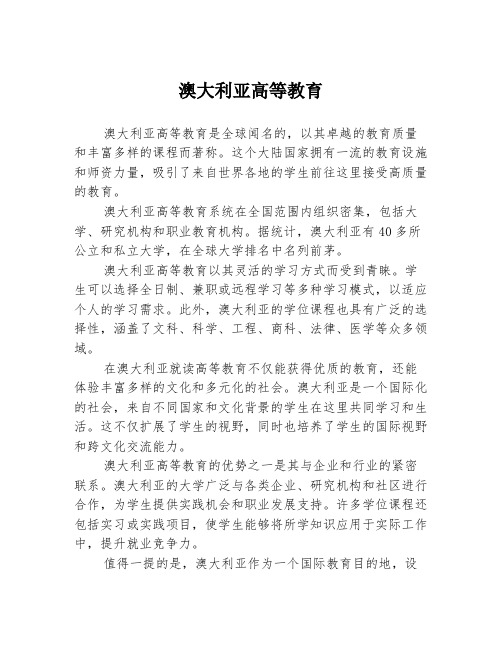
澳大利亚高等教育澳大利亚高等教育是全球闻名的,以其卓越的教育质量和丰富多样的课程而著称。
这个大陆国家拥有一流的教育设施和师资力量,吸引了来自世界各地的学生前往这里接受高质量的教育。
澳大利亚高等教育系统在全国范围内组织密集,包括大学、研究机构和职业教育机构。
据统计,澳大利亚有40多所公立和私立大学,在全球大学排名中名列前茅。
澳大利亚高等教育以其灵活的学习方式而受到青睐。
学生可以选择全日制、兼职或远程学习等多种学习模式,以适应个人的学习需求。
此外,澳大利亚的学位课程也具有广泛的选择性,涵盖了文科、科学、工程、商科、法律、医学等众多领域。
在澳大利亚就读高等教育不仅能获得优质的教育,还能体验丰富多样的文化和多元化的社会。
澳大利亚是一个国际化的社会,来自不同国家和文化背景的学生在这里共同学习和生活。
这不仅扩展了学生的视野,同时也培养了学生的国际视野和跨文化交流能力。
澳大利亚高等教育的优势之一是其与企业和行业的紧密联系。
澳大利亚的大学广泛与各类企业、研究机构和社区进行合作,为学生提供实践机会和职业发展支持。
许多学位课程还包括实习或实践项目,使学生能够将所学知识应用于实际工作中,提升就业竞争力。
值得一提的是,澳大利亚作为一个国际教育目的地,设有一系列优惠政策和奖学金计划,为国际学生提供经济上的支持。
这些政策和计划旨在吸引和留住优秀的国际学生,促进国际交流与合作。
总结而言,澳大利亚高等教育以其高质量的教育、灵活多样的学习方式、多元化的文化和紧密的产学合作受到国内外学生的青睐。
无论是追求学术研究的深造,还是职业发展的提升,澳大利亚的高等教育都能为学生提供良好的教育环境和发展机会。
澳大利亚教育制度
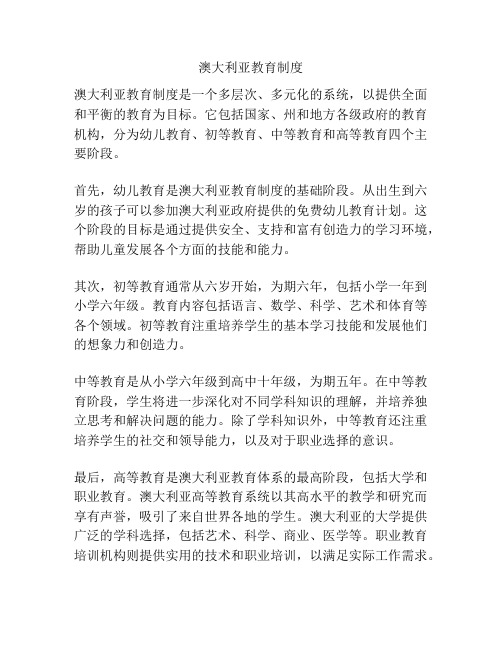
澳大利亚教育制度澳大利亚教育制度是一个多层次、多元化的系统,以提供全面和平衡的教育为目标。
它包括国家、州和地方各级政府的教育机构,分为幼儿教育、初等教育、中等教育和高等教育四个主要阶段。
首先,幼儿教育是澳大利亚教育制度的基础阶段。
从出生到六岁的孩子可以参加澳大利亚政府提供的免费幼儿教育计划。
这个阶段的目标是通过提供安全、支持和富有创造力的学习环境,帮助儿童发展各个方面的技能和能力。
其次,初等教育通常从六岁开始,为期六年,包括小学一年到小学六年级。
教育内容包括语言、数学、科学、艺术和体育等各个领域。
初等教育注重培养学生的基本学习技能和发展他们的想象力和创造力。
中等教育是从小学六年级到高中十年级,为期五年。
在中等教育阶段,学生将进一步深化对不同学科知识的理解,并培养独立思考和解决问题的能力。
除了学科知识外,中等教育还注重培养学生的社交和领导能力,以及对于职业选择的意识。
最后,高等教育是澳大利亚教育体系的最高阶段,包括大学和职业教育。
澳大利亚高等教育系统以其高水平的教学和研究而享有声誉,吸引了来自世界各地的学生。
澳大利亚的大学提供广泛的学科选择,包括艺术、科学、商业、医学等。
职业教育培训机构则提供实用的技术和职业培训,以满足实际工作需求。
澳大利亚教育制度强调个别发展,鼓励学生发展自己的兴趣和潜力。
它提倡学生积极参与课堂和校外活动,注重学生的全面发展。
此外,澳大利亚的教育制度还重视教师的专业培训和发展,以确保他们具备最新的教学知识和技能。
澳大利亚教育制度还注重为学生提供多样化的学习机会。
学生可以选择不同的学习路径,以适应自己的兴趣和能力。
此外,澳大利亚的教育机构也积极推动国际教育交流,为国际学生提供学习和研究的机会。
总之,澳大利亚教育制度致力于为学生提供全面和平衡的教育。
通过幼儿教育、初等教育、中等教育和高等教育四个阶段的连续教育,澳大利亚教育培养学生的各个方面的技能和能力,以适应未来的挑战。
澳大利亚教育制度的灵活性和多样性使其成为世界上一个备受尊重的教育体系。
澳大利亚教育体制
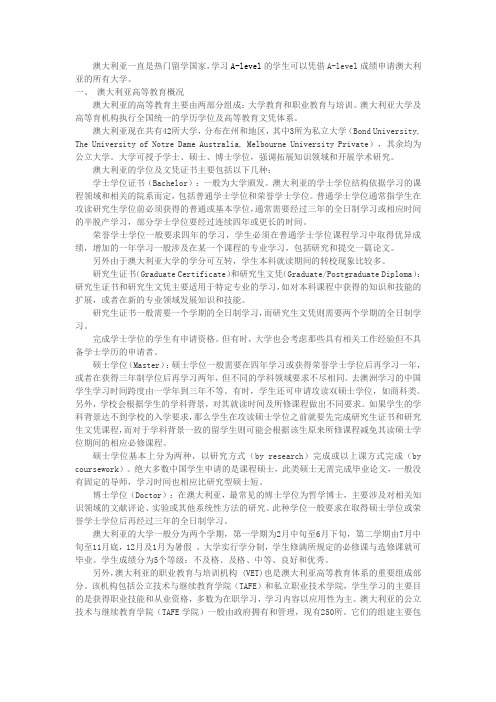
澳大利亚一直是热门留学国家,学习A-level的学生可以凭借A-level成绩申请澳大利亚的所有大学。
一、澳大利亚高等教育概况澳大利亚的高等教育主要由两部分组成:大学教育和职业教育与培训。
澳大利亚大学及高等育机构执行全国统一的学历学位及高等教育文凭体系。
澳大利亚现在共有42所大学,分布在州和地区,其中3所为私立大学(Bond University, The University of Notre Dame Australia, Melbourne University Private),其余均为公立大学。
大学可授予学士、硕士、博士学位,强调拓展知识领域和开展学术研究。
澳大利亚的学位及文凭证书主要包括以下几种:学士学位证书(Bachelor):一般为大学颁发。
澳大利亚的学士学位结构依据学习的课程领域和相关的院系而定,包括普通学士学位和荣誉学士学位。
普通学士学位通常指学生在攻读研究生学位前必须获得的普通或基本学位,通常需要经过三年的全日制学习或相应时间的半脱产学习,部分学士学位要经过连续四年或更长的时间。
荣誉学士学位一般要求四年的学习,学生必须在普通学士学位课程学习中取得优异成绩,增加的一年学习一般涉及在某一个课程的专业学习,包括研究和提交一篇论文。
另外由于澳大利亚大学的学分可互转,学生本科就读期间的转校现象比较多。
研究生证书(Graduate Certificate)和研究生文凭(Graduate/Postgraduate Diploma):研究生证书和研究生文凭主要适用于特定专业的学习,如对本科课程中获得的知识和技能的扩展,或者在新的专业领域发展知识和技能。
研究生证书一般需要一个学期的全日制学习,而研究生文凭则需要两个学期的全日制学习。
完成学士学位的学生有申请资格。
但有时,大学也会考虑那些具有相关工作经验但不具备学士学历的申请者。
硕士学位(Master):硕士学位一般需要在四年学习或获得荣誉学士学位后再学习一年,或者在获得三年制学位后再学习两年,但不同的学科领域要求不尽相同。
- 1、下载文档前请自行甄别文档内容的完整性,平台不提供额外的编辑、内容补充、找答案等附加服务。
- 2、"仅部分预览"的文档,不可在线预览部分如存在完整性等问题,可反馈申请退款(可完整预览的文档不适用该条件!)。
- 3、如文档侵犯您的权益,请联系客服反馈,我们会尽快为您处理(人工客服工作时间:9:00-18:30)。
$8,217
$10,106
Support for Students
Commonwealth supported students: Maximum student contribution amounts
2008
Student contribution band
Band 3 Law, dentistry, medicine, veterinary science, accounting, administration, economics, commerce Mathematics, statistics, computing, built environment, health, engineering, science, surveying, agriculture Humanities, behavioural science, social studies, foreign languages, visual and performing arts Education, nursing
Fees and C harges 22%
Upfront Student C ontributions 3%
State and Local Government Financial Assistance 4%
FEE-HELP - Australian Government Payments 2%
HEC S-HELP - Australian Government Payments 11%
• • • • • Overview of Australia’s Higher Education system Role of Government Funding the system Ensuring quality Recent developments
– 2008-09 Budget measures – Review of Australian Higher Education
– 2 private universities, and one branch of an overseas university
– 3 self accrediting providers – ≈ 150 other higher education providers approved by State and territory legislation
200,000
0
19 49 19 51 19 53 19 55 19 57 19 59 19 61 19 63 19 65 19 67 19 69 19 71 19 73 19 75 19 77 19 79 19 81 19 83 19 85 19 87 19 89 19 91 19 93 19 95 19 97 19 99 20 01 20 01 20 03 20 05 20 07
– indexed annually in line with the Consumer Price Index
• Income contingent – repay when income meets the income threshold through the taxation system
澳大利亚的高等教育
Australian Higher Education
1、多样化——创办特色是时代的要求。
2、创办特色是研究生教育发展的必由之路。
3、 美国25所最受欢迎的大学:凭借各自的特点 4、怎样创办特色?
5、以特色取胜:新时代的普遍规律。
一、创办特色是时代的要求
Today’s presentation
nstitutions: funding student places
• Key elements in funding of undergraduate and postgraduate non-research places: – Commonwealth Grant Scheme – Student contributions and fees – Higher Education Loan Programme (HELP) • HECS-HELP • FEE-HELP • OS-HELP • Other funding for specific purposes – eg. Higher Education Endowment Fund, Capital Development Pool, Diversity and Structural Adjustment Fund, Learning and Teaching Performance Fund.
Full Year Data for 2001 to 2006 842,183 (2001) 1,029,846 ( 2007)
1,000,000
800,000
600,000
221,281 includes teacher colleges (1973)
400,000
110,250 includes colleges of advanced education (1965) 31,753 (1949)
• How is the system funded?
Higher education sector revenue 2006
C onsultancy and C ontracts 5% Investment Revenue 4% Other Income ** 7% Australian Government Grants 42%
Location of institutions
• What is the Government’s role?
Two levels of government
• State and Territory governments have major legislative responsibilities • Australian Government has significant financial and policy responsibility
• Demand
• What does the Australian higher education system look like?
Size and shape of the sector
• Diverse higher education sector, including:
– 37 public universities
• Loan scheme to help eligible students pay for: – student contributions (HECS-HELP) – tuition fees (FEE-HELP) – overseas study expenses (OS-HELP) • No interest
Australian Government responsibilities
• Provides the bulk of public funding to universities • Ensures providers meet quality and accountability requirements, including: – financial viability requirements; – quality requirements; – fairness requirements; – compliance requirements; and – contribution and fee requirements. • These apply to Australian universities, overseas universities operating in Australia and other higher education providers that receive Australian Government funding under the Higher Education Support Act 2003.
•
Student numbers:
– ≈ 756,000 domestic students* – ≈ 273,000 overseas students*
•
*2007 latest data
Higher education enrolments, 1949 to present
1,200,000
Funding provided to institutions: Commonwealth Grant Scheme • Major source of Australian Government funding – in 2007,
$3.5 billion. • Provides transparency and fairness by funding all higher education providers for student places on the same basis. • Australian Government provides a contribution, set by discipline, towards the cost of an agreed number of Commonwealth supported places. • Includes: Regional loading Enabling loading Medical student loading
Funding cluster rates in 2007 and 2008
Disciplines in new clusters Law Accounting, Administration, Economics, Commerce Humanities Mathematics and Statistics Behavioural Science and Social Studies Education Computing, Built Environment, other Health Clinical Psychology Allied Health Foreign Languages, Visual and Performing Arts Nursing Engineering, Science, Surveying Medicine, Dentistry and Veterinary Science Agriculture Funding in 2007 $1,642 $2,703 $4,556 $5,381 $7,233 $7,950 $8,057 $7,233 $8,057 $9,908 $10,953 $13,411 $16,810 $17,870 $11,280 $14,363 $18,227 Funding in 2008 $1,674 $4,647
